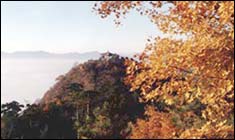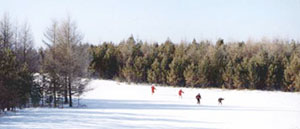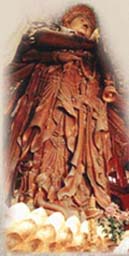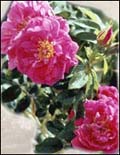History Chengde
In ancient times Chengde was called Rehe. During the Warring States Period, Yan State established the local authorities as the same level as the shire government in this area. And since theQin Dynasty was established, every dynasty did establish its own local government in this area. |
|
In 1703 AD, Emperor Kangxi of the Qing Dynasty constructed the Imperial Summer Resort, and Chengde gradually became a place of important political activity of the Qing Dynasty. Rehe Office was established by the Qing Government until the year of 1723 (the Lst year in the reign of Emper or Yongzheng). In 1733, Chengde State was established, so the name of "Chengde" appeared. After wards Chengde gradually developed into a flourishing city, and population living there was becoming larger and larger. But it is a pity that such a prosperous situation didn't last for a long time. Chengde started to decline from the time in the reign of Emperor Xianfeng to the ruling period of Kuomintang. After the Revolution of 1911, the Rehe Prefecture was established. In 1929 Rehe Province was established, and Chengde became its capital city. After liberation, Chengde started to enter a new page of its life in history. And in July 1993 the original Chengde City was combined with Chengde Prefecture. At present, Chengde City includes eight counties and three districts with a total population of 3.49 million.
Geography Chengde
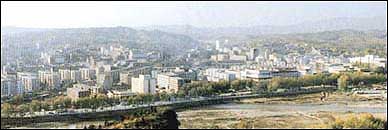
Chengde City is located in the north of Hebei Province and at the foot of Yanshan Mountains. The municipal area is located in the basin on the west bank of Wulie River with altitude 370 meters and it forms a gradient of 3 to 10 percent from the northwest to the southeast. Its geographic location is 115.54 degrees to 119.15 degrees east longitude and 40.12 degress north latitude. It borders Liaoning Province in the east and Inner Mongolia Autonomous Region in the north. Its west border is Zhangjiakou City and Beijing is to its southwest. On its south is Qianxi, Zunhua of Tangshan city and Qinglong of Qinhuangdao City. Thus it is a very important city in the region of Yanshan Mountains and Bohai Sea. The whole area is 35077.4 square kilometers with plow land area of 5,267 thousand hectares.
The general land feature can be divided into the altiplano on the dam and mountainous region below the dam. Main mountains are Yanshan Mountains, Yinshan Mountains, Xing'an Mountains and Seven Old Picture (Qilaotu) Mountains. There are four water systems in the land including Luanhe River, Chaobai River, Jiyun River and Liaohe River.
Climate Chengde
The clim ate in Chengde has a transitional character that is from cold temperate zone to warm temperate zone, from semiarid to semi-moist. It belongs to continental monsoon Yanshan mountainous region climate. It has distinct four seasons and the temperature is distinct especially between day and night. The sunshine here is ample. It is cool in summer and cold in winter. The average temperature is 8.9? in a year, the average amount of rain is 400-800mm, |
|
the average number of no frost days in a year is 73-170 days. January is the coldest month of the year, the average month temperature is 9.4? below zero. The hottest month is July. The annual amount of rain declines gradually from the north to the south. There is little rain and snow in winter and spring. The amount of rain and snow in winter accounts to 1 to 3%, in spring 1 to 13%, in autumn 14 to 19%, in summer 65 to 73%. Because it is monsoon climate in Chengde, the direction of wind changes according to the season. There are 2576-3000 sunshine hours in a year and the annual percent rate of sunshine is 60 to 66%. In May the sunshine hours are the longest, however in November and December they are the shortest.
Natural Ecological Environment Chengde
|
The total area of Chengde is 39.548 square kilometers in which the municipal area is 18.6 square kilometers. In the north there are Seven Old Picture Mountains, heavy forest and broad grassland; in the middle there are Yanshan Mountains, which belong to the zone of hills and high land; |
in the south there are also Yanshan Mountains with overlapped hilltop and deep valley.There are many rivers flowing such as Chaohe River, Luanhe River, Liuhe River, Laoniu River and so on. The altitude in Chengde is 200-1200 meters. Many mountains around the city, unique hills and strange stone form the ten great wonders like Qingchui Peak, Luohan Mountain (Arhat Mountain), Tianqiao Mountain (Over bridge Mountain) and Shuangta Mountain (Mountain with Twin Towers) and so on.
The green covering rate in Chengde is over 30%, and the garbage-disposing rate is above 80%. The average noise level in tourist areas in less than 60 decibel, and above 96% of the used drinking water quality is up to the standard.
Economy Chengde
Chengde has not only the advantage of tourism but also good geographical position and rich natural resources, which provide advantage for the development of economy. Although Chengde is a developing region, the economy in Chengde has been developed fast and gradually a characteristic economy frame has been constructed under the policy of reform and opening-up.
Culture Chengde
Chengde is famous for its history and culture. There are different kinds of schools, 3668 in total. And the number of teaching staff is 36501 in total. A regional education system frame of multi-levels, multi-channels, multi-forms has been established in which basic education, vocational education, adult education, middle and high education are playing an important role including all kinds of non-certificate education.
A Survey of Tourist Industry Chengde
Chengde is located in the Northeast of Hebei Province. It is the regional city under the jurisdiction of province with the whole population of 3.49 million and the area of 40 thousand square kilometers. It consists of three districts and eight counties. There are many scenic spots and historic sites in Chengde, and beautiful natural scenery and nice climate in four seasons. It is one of the 24 Famous History and Culture Cities firstly improved by the State Council and one of the Top 10 Famous Scenic Spots of China and one of the 44 Key Scenic Spots in china and one of the 40 Best Tourist Sites in China. At the end of 1994, the Imperial Summer Resort together with the temples around it was listed as the World Cultural Heritage by the UNESCO. In June 1998, the Imperial summer Resort was confirmed to be one of the 10 model civilized scenic spots of the whole country. At the end of 1998, Chengde City was chosen through public appraisal as the Top Tourist City in China. |
|
Chengde city has abundant travel resources. The government of Chengde City has put 3000 million yuan into rebuilding the well known Imperial Summer Resort and Outer Eight Temples. Now the renovation of forty scenic spots of "Seventy-two Scenic Spots of Emperor Kangxi and Qian long" has been completed.
Seven temples of Outer Eight Temples have been opened to public. Besides, there are newly-opened tourist regions such as Qingchui Peak forest Garden, Kuixing Tower, Twin Towers Mountain. In the county region there are also rich tourist sites. Jinshanling Great Wall is situated in Luanping county; "The First Grassland in the North of Beijing" located in Fengning County has natural beauty and the advantage of good geographical position; In "White Clouds Ancient Caves" (Baiyun Caves), you can see the marvelous spectacle of strange perilous peaks, lovely dells, typical natural beauty and see the Buddhist monks, nuns and Taoists all around; The famous "Mulan Weichang" (Mulan Hunting Site) in Weichang County is the imperial place of the Qing Dynasty for hunting, now it is amice place for cooling off in summer and skiing and hunting in winter; Fog Ghost (Wuling) Mountain in Xinglong county has many kinds of animals and plants which has been confirmed as the nature reserve under the State protection; "Great Wall in the Water" in Kuancheng County is a wonder of the 10,000-li Great Wall; The landscape in the source of Liaohe River in Pingquan is charming;
The wild forest can be seen clearly; the meadow and the vast grassland on the top of the hill appear to be an attractive grassy meadow landscape in high mountains. At present, the projects such as "Tour of Beijing-Chengde World Cultural Heritage", "Tour of Folk Customs", "tour of Skiing and Hunting in Mulan Weichang", "Tour of Forest and Grassland on the Dam (Bashang Grassland)", "Ecological Tour of Beijing-Chengde-Weichang-Fengning-Beijing", "Tour of Historic Sites on the Great Wall in Chengde", "Tour of Scientific Investigation on Fog Ghost Mountain", "Tour of Buddhism" etc. are carried out and very popular among visitors from home and abroad.
Along with the fast development of tourist in dusty, the travel facilities in Chengde City are gradually being improved. There are 21 designated foreign-related hotels, among them 17 are star rated (4 of three stars, 8 of two stars, 5 of one star), there are also the Heaven and Earth (Qianyang) Grand Hotel and the Red Mansion (Honglou) Guesthouse constructed according to four stars grade standard. The whole number of guestrooms of designated foreign-related hotels of the city is more than 3000 guestrooms, altogether 6400 beds.
Besides there are 305 other hotels all over the city and 20 thousand beds. There are 2000 of different kinds of restaurants, among which 21 concerning foreign service and 12 concerning domestic service. They not only have the court dishes, delicious meat and fish dishes but also can serve the inexpensive and daily dishes for the masses.
The traffic in Chengde is very good. The railway and highway network is perfect. In the railway aspect, the special travel train has been established successfully and the time from Beijing to Chengde has shortened from 5 hours in the past to less than 4 hours now. Since 1996, many fast travel train lines have been opened such as from Chengde to Tianjin, from Chengde to Shenyang, from Chengde to Inner Mongolia etc. And the four main train lines Beijing-Chengde, Beijing-Shijiazhuang, Chengde-Shenyang, Beijing-Tonghua have been in use and are very convenient for traveling. At present there are more than 50 travel agencies in Chengde, in which 4 are related to international travel business. Also there are good translation services and travel guides who speak English, Japanese, German, Italian, Spanish, Cantonese and Fujian dialect.
The cultural entertainment in Chengde is very rich and colorful, such as the dancing performance in the imperial palace while the Emperor is having dinner, the traditional dancing performance in Manchu nationality, the charming lights of Putuo, the particular dancing performance just like lots of huge stars round the beautiful moon and the folk dancing and singing performance in primitive and natural villages and villas which win great praise of visitors from home and abroad.
In recent years the tourist industry in Chengde has developed fast. In 1998, 2.9 million people visited Chengde including 90 thousands of foreign tourists and brought the income of 960 million yuan.
City Flower of Chengde
|
When the President of Cambodia Xihanuke and his wife, Princess Monike visited Chengde City on May 29 in 1983, they appreciated very much the flower of Thorn Rose. Hence according to public opinion on March 1st, 1984, the municipal government decided to make the Thorn Rose as the flower of Chengde city.
The thorn rose is the deciduous leaf bush, and it belongs to the rose family in rose genus. It has cold-resistant character,
|
and it is able to resist drought. It likes sunshine and has a longer blossoming period than that of the other common rose, and it is easy to cultivate. Also it is easy to manage and grow vigorously, and the flower is gorgeous. Therefore it fits to be grown in Chengde City. On the other hand, the thorn rose still possesses very high economic value. Its bud, petal and root can be used as medicine. It still has the effect of clearing cold away, detoxifying, stopping bleeding, getting datumescence, decreasing etc. you can make sweet rose syrup, pickle and salt thorn rose. A fragrant tea can be made from the thorn rose, which is a kind of high-quality drink for the guests.
City Tree of Chengde
On March 27, 1988, Japanese pagoda tree was decided as the city tree of Chengde by the government of Chengde City on the basis of the public opinion from the voters and gardening experts.
The pagoda tree is one of the common trees in the North China, and it belongs to deciduous leaf arbors in bean family. |
|
It adapts to the cold and dry climate. And when it is young,it likes to be in the shade, it likes sunshine after it gets mature. And it can grow normally in the various types of soil, and is very easily planted. Its trunk holds straightly, its branch is thick, the crown of the tree forms pearl shape like a big cover, or it is egg-shaped. Planting country pagoda tree in the city area is very suitable since its genuine characteristics of resisting harmful gas such as hydrogen chloride, smoke and dirt etc. are quite strong. Since it is able to decrease the air pollution and improve the quality of the environment, it gets people's deep love. That its characteristics of having deep root being able to resist wind-force and growing quickly is very suitable to windy Chengde City.
Tourist Symbol of Chengde
The tourist symbol of Chengde City is decided by Chengde Tourist Bureau in 1994. The outline of the design is round. In the inner round is the Qingchui Peak representing the natural beauty combined with Shuixin Pavilion (Mid-lake Pavilion), which forms a beautiful picture. Under the pavilion there are two different lines in the degree of thickness, which represents the inverted reflection of the pavilion in the water, and it also can be understood as the wide water surface of Shilizhai Lake and the water of Wulie River. In its lower part is the "Chengde tourism" words written in both Chinese and English. The "CD" (the first two letters of Chengde in English and Pinyin) that forms a circle represents the wall of the villa and the ancient Great Wall in Chengde City. |


